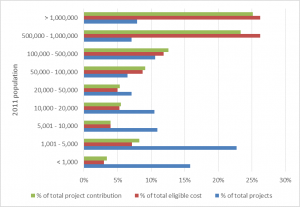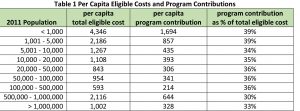Federal Contributions to Infrastructure Projects in Canada
Over the past decade, the federal government has played a prominent role in funding provincial and municipal infrastructure projects. From 2000 to 2015, the federal government contributed $20.3 billion to such projects. Where did all that money go? Did all of the money go to the big cities to fund public transit projects? Were smaller communities in rural Canada overlooked?
To answer these questions, we analyzed the locations of the projects funded under 13 federal infrastructure grant programs from January 2002 to July 2015. We were interested in the distribution of federal contributions by population size of locations that received the contributions.
A total of 8,012 projects received federal infrastructure contributions during the January 2002-July 2015 period. A total of 2,400 locations were recipient of such contributions. Therefore, several locations received multiple project contributions. For example, 18 eligible infrastructure projects in Calgary received federal contributions during the period. Of the 8,012 project contributions, locations of 65 project contributions could not be identified clearly because these were provincial projects with spending on highways, provincial parks, etc.
Over half of the projects—4,100 in total—had a total eligible cost of less than $1 million each. Over all 8,012 projects, the average eligible project cost was $7.4 million, of which the average federal contribution was $2.53 million. Therefore, the average federal contribution to qualifying infrastructure projects was 34 per cent of the total eligible cost of the projects.
Federal contributions did not appear to favor any particular location over others. In terms of the size of location, the smallest to receive federal contribution was Nut Mountain, Saskatchewan with a population of 10, while the largest was the Greater Montreal region with a population of almost four million. In terms of the size of federal contribution, the smallest contribution of $278 went to Trent Hills, Ontario for the rehabilitation of the McCubbin Bridge, while the largest contribution of $704.5 million went to the province of Quebec for Autoroute 30.
Smaller population centers hosted the majority of qualifying projects. A total of 3,967 projects that received federal contributions were in population centers with fewer than 10,000 residents. As shown in Figure 1, that represents over 49 per cent of the total 8,012 qualifying projects that received federal contributions. Population centers with more than 500,000 residents hosted only 15 per cent of the projects that received federal contributions.
Figure 1. Distribution of Projects by Population of Location

In terms of total dollar figures, large population centers benefitted the most by capturing larger shares of total federal contributions despite hosting fewer qualified projects. That, probably, reflects the fact that infrastructure projects that serve large population centers are costly, and therefore, the share of total federal contribution they receive is higher.
However, per capita contribution receipts show a different picture. In terms of per capita, Table 1 shows that the smallest centers—with fewer than 1,000 residents—received more than five times the federal contribution than the largest centers—with population in excess of one million. Locations with more than one million residents received, on average, 33 per cent federal contribution to their infrastructure project costs. That figure was 39 per cent for locations with fewer than 5,000 residents. Locations with population between half-a-million and one-million got 30 per cent of their qualifying infrastructure costs covered through federal contributions, the lowest among locations of any population size.

In conclusion, our study of federal contributions to local infrastructure projects between January 2002 and July 2015 produces three takeaways. First, the federal government contributed, on average, 34 per cent to the cost of financing qualifying local infrastructure projects in Canada during that period, but the contribution rate was higher in smaller communities. Second, smaller communities hosted the majority of the projects that received such federal contributions. Finally, smaller communities received much higher per capita contributions to their infrastructure projects than larger population centers. Overall, smaller communities appeared to have benefitted more than larger population centers through the federal contributions to local infrastructure plans.


